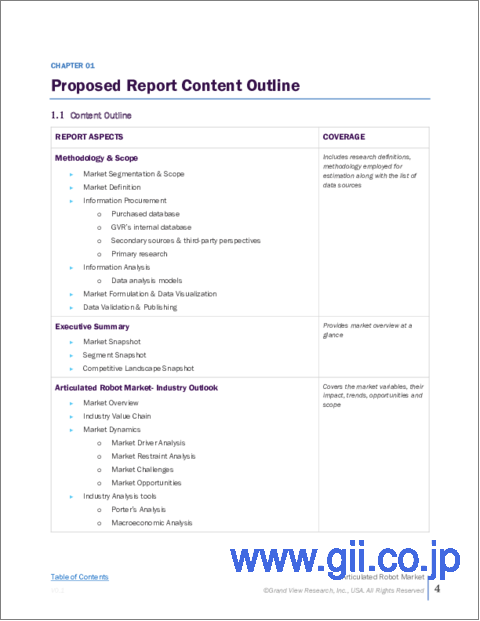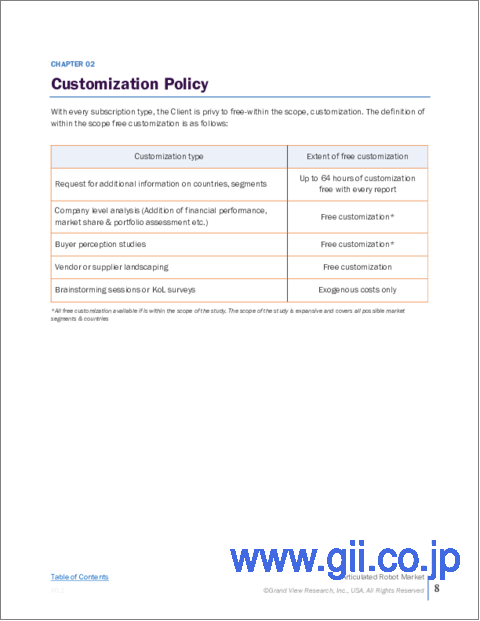|
|
市場調査レポート
商品コード
1530260
多関節ロボットの市場規模、シェア、動向分析レポート:用途別、最終用途別、地域別、セグメント別予測、2024年~2030年Articulated Robot Market Size, Share & Trends Analysis Report By Application (Handling, Wielding, Assembly, Picking, Processing), By End Use, By Region, And Segment Forecasts, 2024 - 2030 |
||||||
カスタマイズ可能
|
|||||||
| 多関節ロボットの市場規模、シェア、動向分析レポート:用途別、最終用途別、地域別、セグメント別予測、2024年~2030年 |
|
出版日: 2024年07月16日
発行: Grand View Research
ページ情報: 英文 150 Pages
納期: 2~10営業日
|
- 全表示
- 概要
- 図表
- 目次
多関節ロボットの市場規模と動向
多関節ロボットの世界市場規模は、2023年に244億8,000万米ドルと推定され、2024年から2030年にかけてCAGR 14.4%で成長すると予測されています。自動化とロボット技術の進歩の高まりが、自動車、エレクトロニクス、製薬など、さまざまな産業で多関節ロボットの需要と採用を促進しています。これらのロボットは、多関節アームによって柔軟性と効率が向上し、複雑な製造工程に適した選択肢となっています。
生産性の向上と運用コストの削減を目的とした製造業の自動化需要の高まりが、多関節ロボット市場の主な促進要因となっています。多関節ロボットは、反復的で労働集約的な作業を自動化するために、製造工程で採用されることが増えています。これらのロボットは、マテリアルハンドリング、組立、溶接、塗装など幅広い機能を高精度かつ高速に実行するようプログラムすることができます。製造業が生産プロセスの最適化を追求する中、多関節ロボットの採用は、効率の向上、ミスの削減、人件費の削減を実現できることから、大きく伸びています。
モノのインターネット(IoT)とインダストリー4.0の原則を統合することで、接続性、自動化、データ交換の強化が可能になり、製造プロセスに革命が起きました。この統合は、製造業におけるロボットの導入に大きな影響を与えています。IoTとインダストリー4.0技術の融合により、相互接続されたデバイスやシステムを通じて、生産プロセスのリアルタイムモニタリング、予知保全、最適化が可能になります。
さらに、協働ロボット(コボット)は、人間の作業者と一緒に働くように設計されており、その安全機能と使いやすさによって人気を集めています。小型化の動向も顕著で、エレクトロニクスやヘルスケア産業向けの小型多関節ロボットが開発されています。さらに、持続可能な製造方法への注目の高まりは、全体的な環境負荷の低減に役立つエネルギー効率の高いロボットの採用につながっており、それによって市場の拡大が加速しています。
農業や物流といった新たな産業における多関節ロボットの用途拡大は、市場プレイヤーに新たなビジネスチャンスをもたらす可能性が高いです。農業分野では、多関節ロボットは作物の収穫、種まき、肥料や農薬の散布、作物の健康状態の監視など、さまざまな作業に活用されています。これらのロボットは、センサーやGPS技術を使って自律的に畑を移動し、高い精度と効率で作業を行うことができます。労働集約的なプロセスを自動化することで、農家は生産性を向上させ、人件費を削減し、資源利用を最適化することができます。さらに、ロボットの能力を強化し、コストを削減するための研究開発が進められており、市場の成長をさらに促進すると期待されています。
目次
第1章 多関節ロボット市場:調査手法と範囲
第2章 多関節ロボット市場:エグゼクティブサマリー
- 市場スナップショット
- セグメントスナップショット
- 競合情勢のスナップショット
第3章 多関節ロボット市場:業界展望
- 市場の系譜
- 業界バリューチェーン分析
- 市場力学
- 業界の機会と課題
- 業界分析ツール
第4章 多関節ロボット市場の用途別展望
- 用途別多関節ロボット市場シェア、2018年-2030年
- 用途別変動分析と市場シェア、2023年と2030年
- 用途別市場推計・予測
第5章 多関節ロボット市場のロケーション別展望
- ロケーション別多関節ロボットの市場シェア、2018年-2030年
- ロケーション別変動分析と市場シェア、2023年と2030年
- ロケーション別市場推計・予測
第6章 多関節ロボットの地域展望
- 地域別関節ロボット市場シェア、2023年および2030年
- 北米
- 北米関節ロボット市場の推定と予測、2018年-2030年
- 米国
- カナダ
- メキシコ
- 欧州
- 欧州の多関節ロボット市場の推定と予測、2018年-2030年
- 英国
- ドイツ
- イタリア
- フランス
- スペイン
- アジア太平洋
- アジア太平洋地域の多関節ロボット市場の推定と予測、2018年-2030年
- 中国
- 日本
- 韓国
- インド
- オーストラリア
- ラテンアメリカ
- 南米ロボット市場の推定と予測、2018年-2030年
- ブラジル
- メキシコ
- 中東・アフリカ
- 中東・アフリカ多関節ロボット市場の推定と予測、2018-2030
- サウジアラビア
- アラブ首長国連邦
第7章 多関節ロボット市場-競合情勢
- 主要市場参入企業による最近の動向と影響分析
- 企業分類
- 参入企業の概要
- 財務実績
- 製品ベンチマーク
- 企業の市場ポジショニング
- 企業市場シェア分析、2023年
- 企業ヒートマップ分析
- 戦略マッピング
- 新製品の発売
- 拡大
- 合併と買収
- コラボレーション
- 企業プロファイル
- ABB Limited
- Comau
- FANUC
- Kawasaki Heavy Industries
- KUKA
- Mitsubishi Electric
- Omron Adept Technologies
- Seiko Epson Corporation
- Stabuli
- Yaskawa Electric
List of Tables
- Table 1 Articulated Robot Market - Key Market Driver Impact
- Table 2 Global Articulated Robot Market - Key Market Restraint Impact
- Table 3 Global Articulated Robot Market - Key Market Opportunities
- Table 4 Global Articulated Robot Market - Key Market Challenges
- Table 5 Articulated Robot Market Revenue Estimates and Forecast, By Application, 2018 - 2030 (USD Billion)
- Table 6 Articulated Robot Market Revenue Estimates and Forecast, By Location, 2018 - 2030 (USD Billion)
- Table 7 Recent Developments & Impact Analysis, By Key Market Participants
- Table 8 Company Heat Map Analysis
- Table 9 Key Companies Launching New Products
- Table 10 Key Companies Pursuing Expansions
- Table 11 Key Companies Pursuing Mergers & Acquisitions
- Table 12 Key Companies Collaborations
List of Figures
- Fig. 1 Market Segmentation And Scope
- Fig. 2 Information Procurement
- Fig. 3 Data Analysis Models
- Fig. 4 Market Formulation And Validation
- Fig. 5 Data Validating & Publishing
- Fig. 6 Market Snapshot
- Fig. 7 Segment Snapshot (1/2)
- Fig. 8 Segment Snapshot (2/2)
- Fig. 9 Competitive Landscape Snapshot
- Fig. 10 Global Articulated Robot, 2018 - 2030 (USD Billion)
- Fig. 11 Articulated Robot Market - Value Chain Analysis
- Fig. 12 Articulated Robot Market - Market Dynamics
- Fig. 13 Articulated Robot Market - Porter's Five Forces Analysis
- Fig. 14 Articulated Robot Market - PESTEL Analysis
- Fig. 15 Articulated Robot , By Application : Key Takeaways
- Fig. 16 Articulated Robot , By Application : Market Share, 2023 & 2030
- Fig. 17 Handling Articulated Robot Market Estimates & Forecasts, 2018 - 2030 (USD Billion)
- Fig. 18 Weilding Articulated Robot Market Estimates & Forecasts, 2018 - 2030 (USD Billion)
- Fig. 19 Assembly Articulated Robot Market Estimates & Forecasts, 2018 - 2030 (USD Billion)
- Fig. 20 Picking Articulated Robot Market Estimates & Forecasts, 2018 - 2030 (USD Billion)
- Fig. 21 Processing Articulated Robot Market Estimates & Forecasts, 2018 - 2030 (USD Billion)
- Fig. 22 Others Articulated Robot Market Estimates & Forecasts, 2018 - 2030 (USD Billion)
- Fig. 23 Articulated Robot , By Location: Key Takeaways
- Fig. 24 Articulated Robot , By Location : Market Share, 2023 & 2030
- Fig. 25 Automotive Market Estimates & Forecasts, 2018 - 2030 (USD Billion)
- Fig. 26 Electrical & Electronics Market Estimates & Forecasts, 2018 - 2030 (USD Billion)
- Fig. 27 Metal & Machinery Market Estimates & Forecasts, 2018 - 2030 (USD Billion)
- Fig. 28 Transportation & Logistics Market Estimates & Forecasts, 2018 - 2030 (USD Billion)
- Fig. 29 Chemical Market Estimates & Forecasts, 2018 - 2030 (USD Billion)
- Fig. 30 Food Market Estimates & Forecasts, 2018 - 2030 (USD Billion)
- Fig. 31 Others Market Estimates & Forecasts, 2018 - 2030 (USD Billion))
- Fig. 32 Articulated Robot Market Revenue By Region, 2023 & 2030 (USD Billion)
- Fig. 33 Regional Marketplace: Key Takeaways
- Fig. 34 Regional Marketplace: Key Takeaways
- Fig. 35 North America Articulated Robot Market Estimates & Forecast, 2018 - 2030 (USD Billion)
- Fig. 36 U.S. Articulated Robot Market Estimates & Forecast, 2018 - 2030 (USD Billion)
- Fig. 37 Canada Articulated Robot Market Estimates & Forecast, 2018 - 2030 (USD Billion)
- Fig. 38 Mexico Articulated Robot Market Estimates & Forecast, 2018 - 2030 (USD Billion)
- Fig. 39 Europe Articulated Robot Market Estimates & Forecast, 2018 - 2030 (USD Billion)
- Fig. 40 Germany Articulated Robot Market Estimates & Forecast, 2018 - 2030 (USD Billion)
- Fig. 41 U.K. Articulated Robot Market Estimates & Forecast, 2018 - 2030 (USD Billion)
- Fig. 42 France Articulated Robot Market Estimates & Forecast, 2018 - 2030 (USD Billion)
- Fig. 43 Italy Articulated Robot Market Estimates & Forecast, 2018 - 2030 (USD Billion)
- Fig. 44 Spain Articulated Robot Market Estimates & Forecast, 2018 - 2030 (USD Billion)
- Fig. 45 Asia Pacific Articulated Robot Market Estimates & Forecast, 2018 - 2030 (USD Billion)
- Fig. 46 China Articulated Robot Market Estimates & Forecast, 2018 - 2030 (USD Billion)
- Fig. 47 India Articulated Robot Market Estimates & Forecast, 2018 - 2030 (USD Billion)
- Fig. 48 Japan Articulated Robot Market Estimates & Forecast, 2018 - 2030 (USD Billion)
- Fig. 49 Australia Articulated Robot Market Estimates & Forecast, 2018 - 2030 (USD Billion)
- Fig. 50 South Korea Articulated Robot Market Estimates & Forecast, 2018 - 2030 (USD Billion)
- Fig. 51 Latin America Articulated Robot Market Estimates & Forecast, 2018 - 2030 (USD Billion)
- Fig. 52 Brazil Articulated Robot Market Estimates & Forecast, 2018 - 2030 (USD Billion)
- Fig. 53 Mexico Articulated Robot Market Estimates & Forecast, 2018 - 2030 (USD Billion)
- Fig. 54 MEA Articulated Robot Market Estimates & Forecast, 2018 - 2030 (USD Billion)
- Fig. 55 Saudi Arabia Articulated Robot Market Estimates & Forecast, 2018 - 2030 (USD Billion)
- Fig. 56 South Africa Articulated Robot Market Estimates & Forecast, 2018 - 2030 (USD Billion)
- Fig. 57 UAE Articulated Robot Market Estimates & Forecast, 2018 - 2030 (USD Billion)
- Fig. 58 Key Company Categorization
- Fig. 59 Strategic Framework
Articulated Robot Market Size & Trends
The global articulated robot market size was estimated at USD 24.48 billion in 2023 and is expected to grow at a CAGR of 14.4% from 2024 to 2030. The growing advancements in automation and robotics technology is driving the demand and the adoption of articulated robots across various industries, including automotive, electronics, and pharmaceuticals.These robots, with their multi-jointed arms, provide enhanced flexibility and efficiency, making them a preferred choice for complex manufacturing processes.
The rising demand for automation in manufacturing to improve productivity and reduce operational costs is a major driver of the articulated robots market. Articulated robots are increasingly being adopted in manufacturing processes to automate repetitive and labor-intensive tasks. These robots can be programmed to perform a wide range of functions, such as material handling, assembly, welding, and painting, with high precision and speed. As manufacturers seek to optimize their production processes, the adoption of articulated robots has grown significantly, as they can enhance efficiency, reduce errors, and lower labor costs.
Integrating the Internet of Things (IoT) and Industry 4.0 principles has revolutionized manufacturing processes by enabling enhanced connectivity, automation, and data exchange. This integration has significantly impacted the adoption of robots in manufacturing industries. The convergence of IoT with Industry 4.0 technologies allows for real-time monitoring, predictive maintenance, and optimization of production processes through interconnected devices and systems.
Furthermore, collaborative robots, or cobots, which are designed to work alongside human workers, are gaining popularity owing to their safety features and ease of use. The trend towards miniaturization is also notable, with smaller and more compact articulated robots being developed for applications in the electronics and healthcare industries. Moreover, the increasing focus on sustainable manufacturing practices is leading to the adoption of energy-efficient robots that help reduce the overall environmental impact, thereby accelerating the market expansion.
The expanding applications of articulated robots in new industries, such as agriculture and logistics, are likely to open up new opportunities for market players. In the agriculture industry, articulated robots are being utilized for various tasks such as harvesting crops, planting seeds, applying fertilizers and pesticides, and monitoring crop health. These robots can navigate through fields autonomously using sensors and GPS technology to perform tasks with high accuracy and efficiency. By automating labor-intensive processes, farmers can increase productivity, reduce labor costs, and optimize resource utilization. Additionally, the ongoing research and development efforts to enhance robot capabilities and reduce costs is expected to further drive the market growth.
Global Articulated Robot Market Report Segmentation
This report forecasts revenue growth at global, regional, and country levels and provides an analysis of the latest industry trends in each of the sub-segments from 2018 to 2030. For this study, Grand View Research has segmented the global Articulated Robot market report based on application, end use, and region:
- Application Outlook (Revenue, USD Billion, 2018 - 2030)
- Handling
- Wielding
- Assembly
- Picking
- Processing
- Others
- End Use Outlook (Revenue, USD Billion, 2018 - 2030)
- Automotive
- Electrical and Electronics
- Metal and Machinery
- Transportation and Logistics
- Chemical
- Food
- Others
- Regional Outlook (Revenue, USD Billion, 2018 - 2030)
- North America
U.S.
Canada
Mexico
- Europe
UK
Germany
France
Italy
Spain
- Asia Pacific
China
Australia
Japan
India
South Korea
- Latin America
Brazil
- Middle East & Africa
South Africa
Saudi Arabia
UAE
Table of Contents
Chapter 1 Articulated Robot Market: Methodology and Scope
- 1.1 Market Segmentation & Scope
- 1.2 Market Definitions
- 1.3 Information Procurement
- 1.3.1 Information analysis
- 1.3.2 Market formulation & data visualization
- 1.3.3 Data validation & publishing
- 1.4 Research Scope and Assumptions
- 1.4.1 List to data sources
Chapter 2 Articulated Robot Market: Executive Summary
- 2.1 Market Snapshot
- 2.2 Segment Snapshot
- 2.3 Competitive Landscape Snapshot
Chapter 3 Articulated Robot Market: Industry Outlook
- 3.1 Market Lineage
- 3.2 Industry Value Chain Analysis
- 3.3 Market Dynamics
- 3.3.1 Market driver analysis
- 3.3.2 Market challenge analysis
- 3.4 Industry Opportunities & Challenges
- 3.5 Industry Analysis Tools
- 3.5.1 Porter's analysis
- 3.5.2 Macroeconomic analysis
Chapter 4 Articulated Robot Market Application Outlook
- 4.1 Articulated Robot Market Share By Application, 2018 - 2030 (USD Billion)
- 4.2 Application Movement Analysis & Market Share, 2023 & 2030
- 4.3 Articulated Robot Market Estimates & Forecast, By Application (USD Billion)
- 4.3.1 Handling
- 4.3.2 Weilding
- 4.3.3 Assembly
- 4.3.4 Picking
- 4.3.5 Processing
- 4.3.6 Others
Chapter 5 Articulated Robot Market Location Outlook
- 5.1 Articulated Robot Market Share By Location, 2018 - 2030 (USD Billion)
- 5.2 Location Movement Analysis & Market Share, 2023 & 2030
- 5.3 Articulated Robot Market Estimates & Forecast, By Location (USD Billion)
- 5.3.1 Automotive
- 5.3.2 Electrical & Electronics
- 5.3.3 Metal & Machinery
- 5.3.4 Transportation & Logistics
- 5.3.5 Chemical
- 5.3.6 Food
- 5.3.7 Others
Chapter 6 Articulated Robot Regional Outlook
- 6.1 Articulated Robot Market Share By Region, 2023 & 2030
- 6.2 North America
- 6.2.1 North America Articulated Robot Market Estimates & Forecasts, 2018 - 2030 (USD Billion)
- 6.2.2 U.S.
- 6.2.3 Canada
- 6.2.4 Mexico
- 6.3 Europe
- 6.3.1 Europe Articulated Robot Market Estimates & Forecasts, 2018 - 2030 (USD Billion)
- 6.3.2 UK
- 6.3.3 Germany
- 6.3.4 Italy
- 6.3.5 France
- 6.3.6 Spain
- 6.4 Asia Pacific
- 6.4.1 Asia Pacific Articulated Robot Market Estimates & Forecasts, 2018 - 2030 (USD Billion)
- 6.4.2 China
- 6.4.3 Japan
- 6.4.4 South Korea
- 6.4.5 India
- 6.4.6 Australia
- 6.5 Latin America
- 6.5.1 South America Articulated Robot Market Estimates & Forecasts, 2018 - 2030 (USD Billion)
- 6.5.2 Brazil
- 6.5.3 Mexico
- 6.6 MEA
- 6.6.1 MEA Articulated Robot Market Estimates & Forecasts, 2018 - 2030 (USD Billion)
- 6.6.2 Saudi Arabia
- 6.6.3 UAE
Chapter 7 Articulated Robot Market - Competitive Landscape
- 7.1 Recent Developments & Impact Analysis, By Key Market Participants
- 7.2 Company Categorization
- 7.3 Participant's Overview
- 7.4 Financial Performance
- 7.5 Product Benchmarking
- 7.6 Company Market Positioning
- 7.7 Company Market Share Analysis, 2023
- 7.8 Company Heat Map Analysis
- 7.9 Strategy Mapping
- 7.9.1 New Product Launches
- 7.9.2 Expansion
- 7.9.3 Mergers & Acquisitions
- 7.9.4 Collaborations
- 7.10 Company Profiles
- 7.10.1 ABB Limited
- 7.10.1.1 Participant's Overview
- 7.10.1.2 Financial Performance
- 7.10.1.3 Product Benchmarking
- 7.10.1.4 Recent Developments
- 7.10.2 Comau
- 7.10.2.1 Participant's Overview
- 7.10.2.2 Financial Performance
- 7.10.2.3 Product Benchmarking
- 7.10.2.4 Recent Developments
- 7.10.3 FANUC
- 7.10.3.1 Participant's Overview
- 7.10.3.2 Financial Performance
- 7.10.3.3 Product Benchmarking
- 7.10.3.4 Recent Developments
- 7.10.4 Kawasaki Heavy Industries
- 7.10.4.1 Participant's Overview
- 7.10.4.2 Financial Performance
- 7.10.4.3 Product Benchmarking
- 7.10.4.4 Recent Developments
- 7.10.5 KUKA
- 7.10.5.1 Participant's Overview
- 7.10.5.2 Financial Performance
- 7.10.5.3 Product Benchmarking
- 7.10.5.4 Recent Developments
- 7.10.6 Mitsubishi Electric
- 7.10.6.1 Participant's Overview
- 7.10.6.2 Financial Performance
- 7.10.6.3 Product Benchmarking
- 7.10.6.4 Recent Developments
- 7.10.7 Omron Adept Technologies
- 7.10.7.1 Participant's Overview
- 7.10.7.2 Financial Performance
- 7.10.7.3 Product Benchmarking
- 7.10.7.4 Recent Developments
- 7.10.8 Seiko Epson Corporation
- 7.10.8.1 Participant's Overview
- 7.10.8.2 Financial Performance
- 7.10.8.3 Product Benchmarking
- 7.10.8.4 Recent Developments
- 7.10.9 Stabuli
- 7.10.9.1 Participant's Overview
- 7.10.9.2 Financial Performance
- 7.10.9.3 Product Benchmarking
- 7.10.9.4 Recent Developments
- 7.10.10 Yaskawa Electric
- 7.10.10.1 Participant's Overview
- 7.10.10.2 Financial Performance
- 7.10.10.3 Product Benchmarking
- 7.10.10.4 Recent Developments
- 7.10.1 ABB Limited






